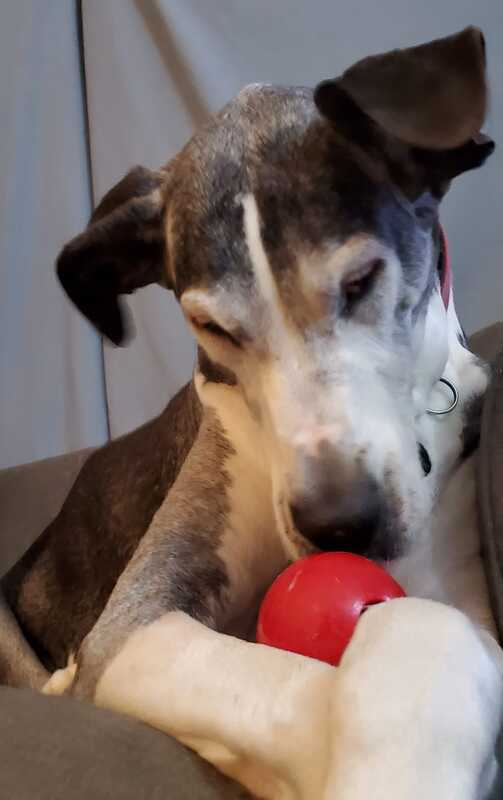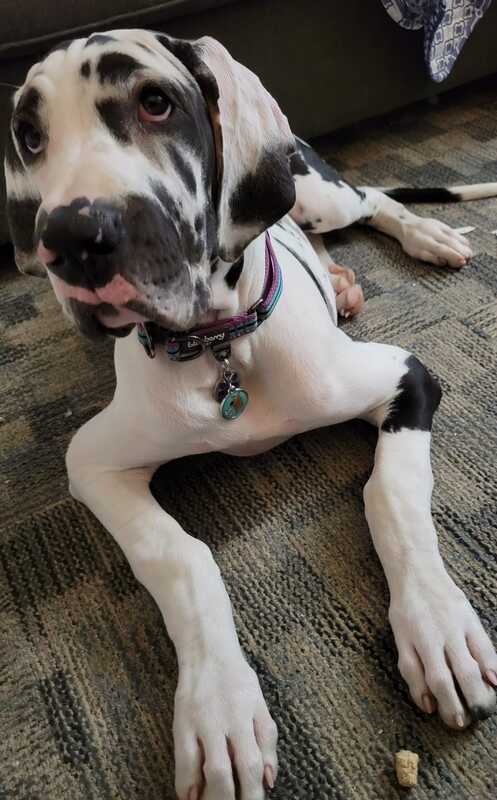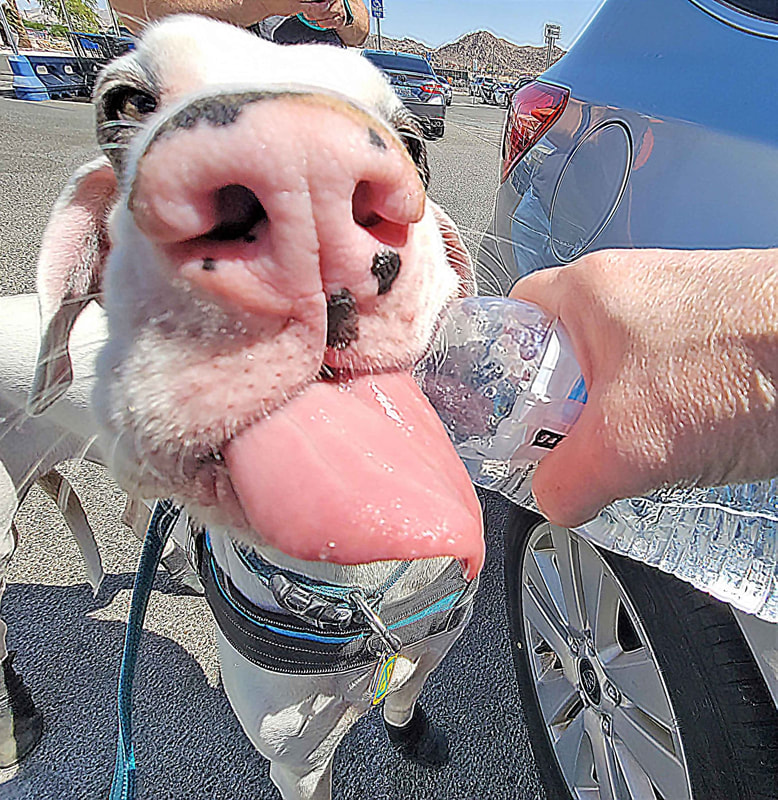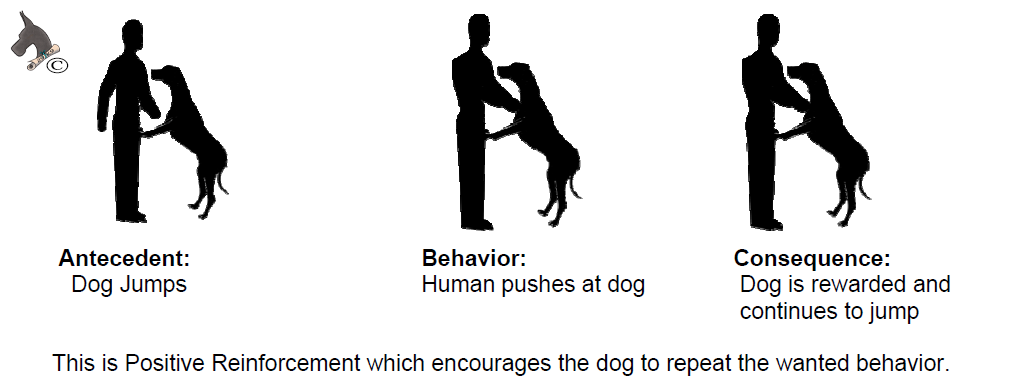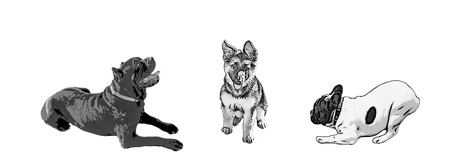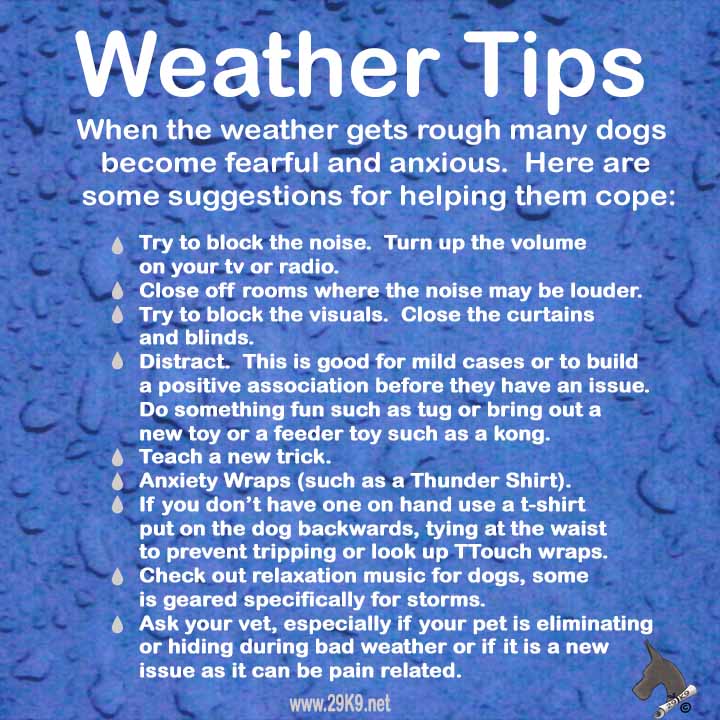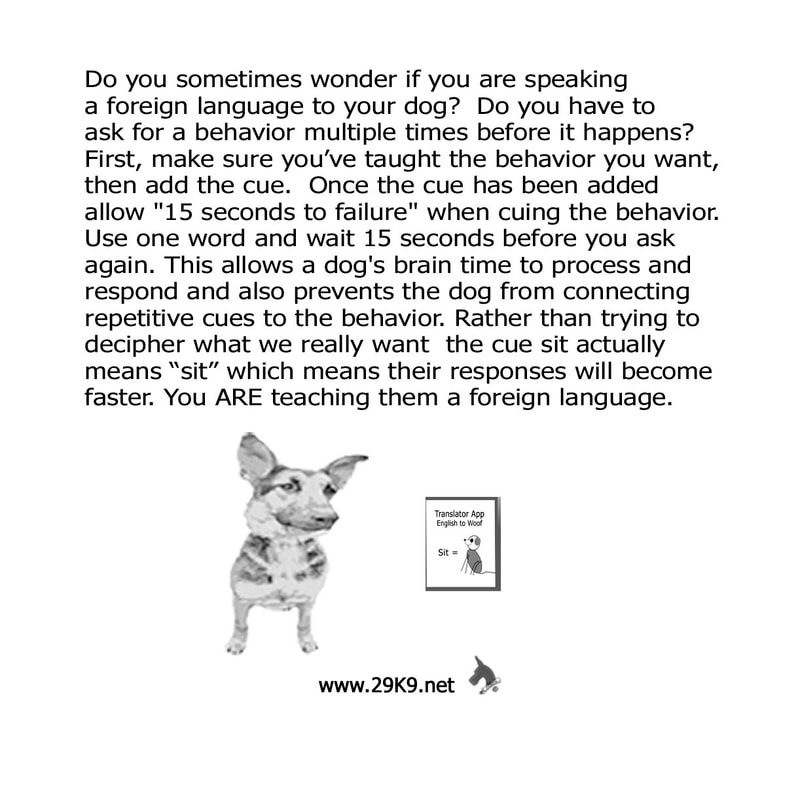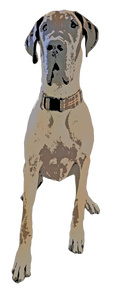 Why are we always asking for the sit? It has always seemed like the good “obedient” choice on our part for our dog to provide. I’ve been in that place myself. I wanted my Great Dane to sit patiently. Then I had an epiphany. Last year we brought our adolescent dane RuhRoh to a group class. Hubby kept asking her to sit. She was being a very good dog, she was calmly greeting people and dogs. She was walking with a loose leash. She was being such a freaking good dog! However she would not sit on cue in that environment. So why were we upset? Aside from being embarrassed, it was the way WE had been trained, the dog should sit. It is the first behavior we are taught in training school and in training classes. It's time to rethink sit, and here are some of the reasons why as well as how SIT may not be the best option for our dogs. 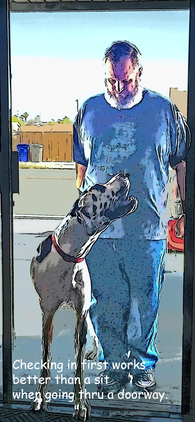 1. Sit before entering a doorway. Why should our dog have to sit before entering a doorway? In the old days it was thought that if a dog entered first they were trying to be dominant over us. In actuality they are usually just excited about what is on the other side. As an alternative polite behavior a "check in" and pause will help you and your dog be on the same page, is usually faster and adds another step in a relationship built on respect.
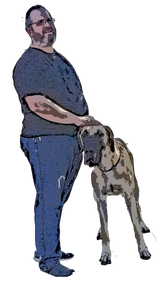 Things to think about: Some surfaces may be hot, hard, rocky or in some other way uncomfortable to our dog. Finally, and most important, as a dog ages those sits can become painful and hard on the hips. "Standing waits" will give you and your dog calm go-to skills that are much more convenient to both you and your dog. To teach this behavior while the dog is standing next to you say their name and reward when they look at you. Practice it a lot, then take it to the doorway, both going out and in. Do this when your hands aren’t full or you aren’t wrangling children, so that they make the connection that waiting calmly is worthwhile. Then add in distractions such as carrying a bag or box, engage a friend to help with greetings on walks. One step at a time.
0 Comments
Stub-born: /ˈstəbərn/ adjetive
having or showing dogged determination not to change one's attitude or position on something, especially in spite of good arguments or reasons to do so. Have you ever referred to your dog as stubborn or had another trainer say this about your dog? Is the dog actually stubborn or is the human? If we keep doing something that is not working and we know it isn't working then aren't we being the stubborn ones? Especially if we know there are other methods that may work better? First we need to find proper motivation. Just like we may be motivated by different things, so are dogs. Using my own dogs as an example I have one that is ball or toy motivated. She will do anything, absolutely anything, for a ball or squeaky toy. I have one that is very food motivated. Especially when it comes to cheese. Then I have one that will do anything to get a drink of water from a water bottle. Last, our newest arrival, changes what motivates him. Sometimes it's food and sometimes it's attention. Motivation can change, depending upon their mood (and if they are hungry). Learning what motivates them gives us a better relationship, mutual respect and a less frustration. What doesn't motivate? Punishment. Punishment suppresses, it does not build a relationship based on respect or trust. It also causes confusion and can lead to fall out behaviors of anxiety, fearfulness, and even aggression. Does your dog have a behavior that is driving you nuts? Perhaps they are getting into the garbage, counter surfing or jumping on people. Every time Fido does this unwarned behavior he is rewarded. Either by your attention or his prize off the counter or garbage can. To resolve the unwanted behavior we have to first identify what we would like them to do instead. Then we put in a management plan to prevent the dog from doing the unwanted behavior while we work on the new skill.
Management is the most important step because every time the dog does the unwanted behavior that bad habit is reinforced, sometimes unintentionally and sometimes the behavior is self rewarding. which makes it much more likely to continue. If you push a dog away while they jump they are excited and rewarded by the attention. Counter surfing or getting in the garbage are self rewarding in that they usually find a prize. After we make sure the behavior cannot continue we focus on teaching the new skill and getting it generalized to lots of different environments and situations. Station training for jumping, leave its for the garbage and counter surfing. We also want to add enrichment to keep their brains busy so they are less likely to get into trouble. If you need help we are here. Email [email protected]. 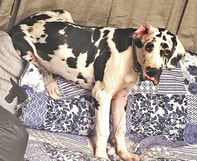 The angst of adolescence. That cute puppy is now an adolescent (think teenager) and has her own opinions and wants what she wants when she wants it. That marble in the brain is rattling around without a place to land How do we deal with adolescence without resorting to aversives which may cause dangerous fallout behaviors later? I'd like to say easy but it isn't. It takes patience, lots of micro training, enrichment and management. 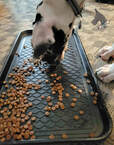 Patience: Remember, this too shall pass. Be patient, you will see the change happening as your dog matures, usually by the age of two. Why 2? Because this is typically when the frontal cortex of the brain is fully developed and the frontal cortex is where self control originates. Micro training: What is micro training? It's small sessions that you can scatter through out the day so that it turns into real life training. Asking for and reinforcing those sits, waits, leave its and settles so that they become habit. Remember, reinforcement drives behavior. You work for cash, your dog works for treats, toys and/or attention. Teaching Fido the calm dog with good behaviors gets the rewards. Enrichment: This is a biggie. Dogs need to use their brains. Mental exercise can tire out a dog just as well as a long walk does. We include it in our day by scatter feeding breakfast, a kong (we have several different versions to keep it mixed up), tricks, putting a few treats in a box, paper towel tube, or a paper lunch bag or even a game of find it.  Management: As the old saying goes, an ounce of prevention is worth a pound of cure. The better you prevent an unwanted behavior from happening the easier it is to teach your dog what you want them to do. Prevent door darting by teaching wait at doorways. Prevent jumping on people by giving them a spot to hang out when your guests arrive. Gate off the kitchen to prevent your dog from counter surfing or getting into the trash. Once these types of behaviors start it is so much harder to stop because they are self rewarding. We shall be grateful that adolescence in dogs is so much less than in humans. Be patient, do lots of small training sessions, engage his brain with enrichment and prevent his opportunity to get into trouble. Show them love and keep them safe. First Introductions
First introductions should be outside, preferably in neutral turf. Take the dogs on a side by side walk. This helps tire an active puppy and while providing a happy back drop before entering the yard and home. Supervise It is important that all early interactions be supervised. Whether a new puppy or an older dog it can take a few weeks for everyone to get used to the new family member and new normal. Watching body language closely during this adjustment period can help prevent future problems. Separate the dogs if you are not able to closely supervise, especially during the first 3 weeks, until they have time to adjust to each other. Separate Baby Gates, crates and Xpens make great separators so that the dogs can have down time where they feel safe and comfortable. Separate eating areas since new puppies can be overly curious and older dogs may not appreciate a puppy interrupting them. Escape Route Make sure there is always an escape route so that the dogs don’t feel cornered. Have a clear path to get away can make the difference in whether a dog goes for the bite or not. No Punishment No matter what happens do not punish either dog. Punishment can make a bad association between the dogs resulting in escalation of aggressive type behaviors. Reward Reward when the dogs are getting along, whether playing with or simply being in the same room, be sure to reward with attention, special treats or even going outside. This will help cement that good things happen when the other dog is around. Intervene Watch for body language that indicates a problem may develop and intervene early with time apart to de-escalate. Older dogs may be tolerant up to a point so watching their eyes, ears, tail position and watch the puppy for signs that he is getting too ‘in the face’ of the older dog and needs time apart to calm down. Time Give the dogs time to become acquainted and adjusted. This creates a foundation rather than forcing them into a relationship that isn’t comfortable. Following the Rule of 3s, after about 3 weeks you should see things moving toward a comfortable co-existence and, depending upon the ages, playing together. Warnings Watch the body language. Lots of licking can be a sign of increasing anxiety which means the dog is not adjusting to the new dog. If the puppy yelps and the older dog does not back off but instead escalates it’s time for a break. You’ve hit the 3 week mark with no improvement. Any of these should net a consult with a fear-free professional. The weather outside is frightful so I thought I'd give a few tips for easing your dog's fears or anxiety during storms.
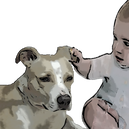 As the song says, "All I'm askin' Is for a little respect". Pet owners often tell me that, in preparation for having a baby, they have started pulling tails and ears in order to get the dog "used to it" before the baby comes. The dog is not 'getting used to it" but is simply tolerating something that is annoying, uncomfortable and may even be painful. It may even increase their anxiety. Tolerance only goes so far, tho, and then a dog may decide enough is enough. If someone was poking you with their finger how long would you tolerate the behavior before finally reacting? You can say "stop" but a dog can only say it thru body language before they eventually resort to biting. If you aren't going to stop your child from pulling the dog's ears then separate them. How does Fido say "enough, I'm not comfortable with this"? You may notice the dog licking you and/or the baby. Yawning. Very round or "whale eye" (where the white is quite visible). Lip licking. Ears pinned back. Tail tucked. Body shifts away. Whining. Lip lifting / showing teeth. Growling. These are all ways the dog is telling you they are not comfortable. What should you NOT do? Punish the dog who is trying to tell you there is a problem. Respect your dog and teaching your child to respect the dog you will help you protect them both. A false sense of security can develop when a baby first comes home. The dog may be curious and even want to be near this new bundle that is taking up so much of your attention. You let your guard down, feeling a sense of relief that Fido appears to be accepting the baby. The baby, tho, is pretty stationary at this point. As months pass and the baby becomes more mobile, as well as more curious about the dog, Fido's anxiety can build. Baby's are unpredictable and some dogs don't handle this as well while some may tolerate for awhile but may eventually say "enough". What SHOULD you do? Institute a very strict supervision and separation plan. Try to keep yourself positioned between the child and the dog, offering treats to the dog. Use stuffed toys to show the child how to pet the dog and make sure you are always there. Teach them to never put their face near a dog's face. Don't leave them alone for a moment as a quick run to another room to get your phone or a soda or that project you were working on could spell disaster, remember dogs and babies are FAST. They only need a moment for something to go wrong. When separating the dog be sure not to make it a punishment. It's a great time for the dog to enjoy a snuffle mat, stuffed Kong, or a favorite toy while in their own space. Hire a reward based or Fear-Free certified trainer who is experienced in behavior challenges, a behaviorist or Veterinary Behaviorist to work with your family and the dog. Talk to the vet and make sure there aren't any physical causes for the dog to be anxious. Even a small tug on an ear or tail or the pat of a hand or a toddler climbing on the dog could be painful for an arthritic dog, prompting the dog to be less tolerant. It's our job to protect both the child AND the dog. The bond between a child and dog can be wonderful but it needs to be safe. 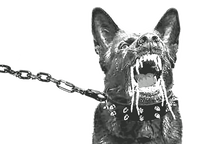 Is your dog reactive to other dogs while on walks? You know what I’m talking about. That sweet, furry love of your life, who turns Cujo-like when he sees certain dogs (or all dogs). You aren't alone, it happens much more often than you realize. When it happens to you, tho, it seems much louder, much worse than when you see another dog react. This is normal because you aren't emotionally invested in someone else's dog but your dog can skewer your heart with this behavior.. You ARE emotionally invested in your dog and this affects how YOU react to your dog's reaction. Embarrassment, nervousness, fear, shame...these are all normal feelings. That's when we typically begin to yell, cajole, threaten, plead for the dog to behave. "It's no big deal" "STOP IT" "C'mon, you know better than to act like this" "ENOUGH already!" Maybe throw in a prong collar or e-collar for good measure to punish the behavior in hopes that it will fix the situation. Instead, tho, the behavior eventually begins to escalate, getting worse. The first step in addressing the behavior is not punishment or bribery but identifying what the dog is trying to tell you. What they are trying to say is usually either “I’m so excited I don’t know how to control my behavior” or “I’m scared and need some space”. Either way your dog is over threshold which means that learning is not going to happen. Trying to yell or beg or bribe will not affect how the dog will react next time So what is a frazzled handler to do? Take a deep breath, step to the side and say “lets go” while turning around and heading the other direction, increasing distance to that which they were reacting to. Once the dog has calmed down and giving you good attention you reward this behavior. Now it is important to make a plan that avoids these situations until your dog is ready and able to handle them. Contact a professional who is experienced and educated in science based methods to work with you and your dog. One who understands that the research is very clear on how to best address the challenges for best results long term and has the experience to teach you and your dog. No flooding, no forcing, no punishment. Solid behavior help instead. Your average dog trainer is just that, a dog trainer. They aren’t educated or experienced in dealing with behavior issues in the best and most modern ways possible. This isn’t about cookie pushing but in timing rewards so that counter conditioning occurs by changing the emotional response to the stimulus (the other dog). Timing is everything, and must occur at precise moments with a high enough value reward while at the same time preventing over threshold or flooding situations where learning does not happen. If you can’t afford a behaviorist there are also online resources, such as CARE For the Reactive Dog, that can help the dog owner learn skills to address their dog’s challenges. Beware of any trainer promising fast fixes…these fixes typically require use of punishment which may suppress the behavior but does not fix the emotional response. This can lead to even more challenging and dangerous behaviors later because the dog is still reacting but with a new level of fear added on. If a friend tries to help you because something worked with their dog remember that not all dogs are the same. Educated and experienced trainers and behaviorists have spent countless hours learning about animal behavior and how to address these things in the best and safest way possible. While your neighbor or friend may mean well, they haven’t put their heart and soul and wallet into learning the best methods to make your dog better.  With the warmer weather (or on rainy days) your dog may not be getting as many walks or even playing in the yard as much. Adding mental stimulation (also called enrichment) to their day can be a big help in curtailing unwanted (and often destructive) behaviors that can be caused by boredom. A few suggestions: Teaching your dog the "find it" game is an easy one to do. Initially you'll do this while the dog watches from a "wait": toss a few treats on the ground and then say "find it". As the dog gets the point of the game hide a few treats in easy to find spots. Then up the ante and hide the treats in harder to find spots and move the dog out of the room. You can also do this game with a favorite toy. 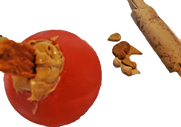 If you have a "stufficidal" dog that can destroy even the toughest of stuffy toys this works great: Use paper towel or toilet paper cardboard inserts. Put a couple of treats in them and then fold the ends. You can also use small boxes or paper bags for this. Lick mats and Kongs are great. We fill them with kibble or treats and then put peanut butter or plain yogurt (be sure it's not sugar free as the sugar substitutes can be dangerous to dogs) and then freeze or chill them (soft drink kosies are great to hold them upright so they don't make a mess in your fridge). This makes the Kong experience last longer.  Freezing ice cube trays or cookie cutters filled with mixture of plain yogurt, canned pumpkin, broth, canned dog food, even blueberries in water are great treats in the heat and interesting to the dog. Hide and seek. One person hides and then the other tells the dog to go find. When the dog gets to the person hiding be sure to ask for a sit before rewarding (in this case you are the reward with big praise and attention.) In addition to alleviating the boredom this also helps your dog learn to give wanted behaviors even when excited. |
Ronda WarywodaCPDT-KA, UW-AAB Categories
All
Archives
July 2023
|

